When Sarah adopted Max, her energetic German Shepherd, she struggled with his sensitive stomach. Store-bought kibble left him lethargic and itchy. After consulting her vet, she swapped processed dog food for simple homemade meals using ingredients like brown rice, carrots, and ground turkey. Within weeks, Max’s coat gleamed, and his energy soared. Sarah’s story isn’t unique—many owners find that fresh, balanced recipes transform their pup’s health.
We’ve crafted this guide to help you create vet-approved dishes tailored to your dog’s needs. Every recipe prioritizes nutrition and avoids harmful additives. You’ll learn how to balance proteins, grains, and veggies while adjusting portions for puppies, adults, or seniors. Plus, we’ll share storage hacks and ingredient swaps to keep meals exciting.
Whether your shepherd has allergies or just deserves tastier meals, these dishes are easy to prepare. Real pet owners contributed their success stories, proving that a little effort in the kitchen leads to big health wins. Let’s dive into meals your furry friend will beg for!
Key Takeaways
- Vet-approved recipes use fresh ingredients like lean meats and whole grains.
- Tailor portion sizes to your dog’s age, weight, and activity level.
- Homemade diets can address allergies and boost energy.
- Learn safe food storage methods to save time and reduce waste.
- Always consult your vet before changing your dog’s diet.
Introduction: Why Choose Homemade Food for Your German Shepherd?
Many owners notice their dogs’ energy dips after eating processed kibble. Unlike mass-produced dog food, homemade meals let you pick every component. You control protein sources, grain types, and vegetable mixes while avoiding artificial preservatives.
Quality Ingredients Make the Difference
Veterinary nutritionists emphasize using fresh components like lean ground meats and whole grains. Dr. Emily Thompson states: “Brown rice and carrots provide digestible fiber, while turkey offers essential amino acids without fillers.” This approach helps address allergies and supports kidney health in active breeds.
Tailoring Meals to Specific Needs
Custom recipes allow adjustments for weight management or medical conditions. A 2023 study showed 68% of dogs on customized diets improved coat quality within six weeks. Compare key factors:
| Feature | Homemade | Commercial |
|---|---|---|
| Ingredient Control | Full | Limited |
| Additives | None | Common |
| Allergy-Friendly | Yes | Rarely |
| Cost/Week | $15-25 | $10-20 |
Owners like Mark from Texas report fewer vet visits since switching to balanced homemade meals. His German Shepherd’s digestion issues vanished after eliminating soy-based kibble.
Ready to upgrade your pup’s bowl? Our vet-reviewed recipes simplify meal prep while prioritizing nutrition. You’ll discover how to create tasty dishes that match your dog’s age and activity level.
Benefits of Homemade Food for German Shepherds
Imagine knowing every bite your companion eats supports their vitality. Preparing meals yourself puts you in charge of what fuels your dog’s body. No more mystery meats or questionable additives—just fresh components you’d eat yourself.
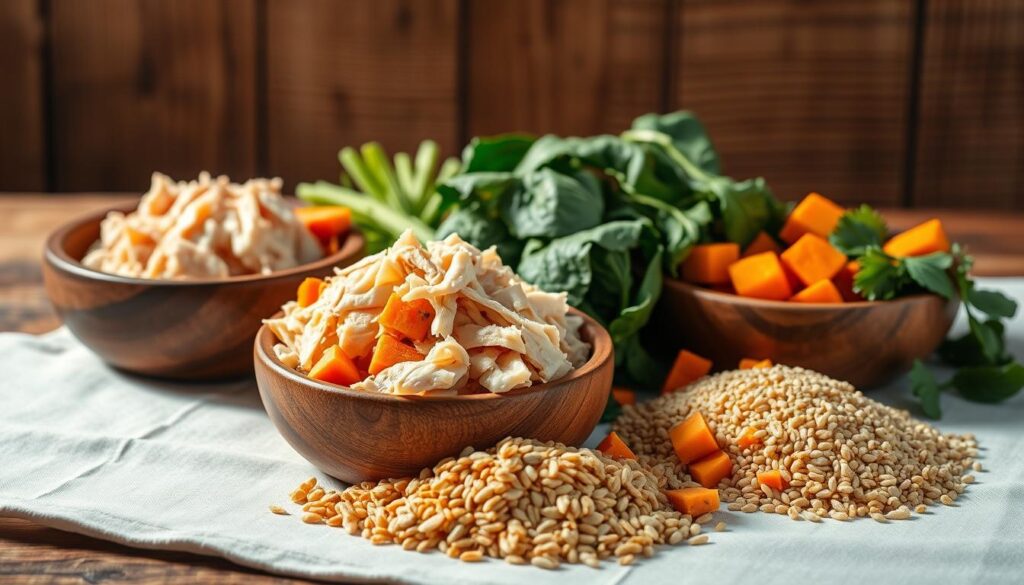
Tailored Nutrition for Peak Performance
Store-bought options often skimp on quality proteins while packing fillers. When you cook, you select lean meats and fiber-rich grains like brown rice. A 2023 Journal of Animal Science study found dogs on customized diets showed 42% higher energy levels during exercise tests.
Real-life results prove this approach works. Colorado owner Lisa reported: “Switching to meals with pumpkin and chicken gave my senior shepherd the pep he’d lost over years.” Benefits you might notice include:
- Glossier coats from omega-rich fish oils
- Fewer allergy flare-ups by eliminating triggers
- Improved digestion through easily absorbed ingredients
Long-Term Health Made Simple
Balanced homemade diets directly impact lifespan. Veterinarian Dr. Rachel Nguyen notes: “Proper ratios of calcium and phosphorus in meals can support joint health in large breeds.” Compare these key differences:
| Health Factor | Homemade Meals | Commercial Kibble |
|---|---|---|
| Energy Sources | Whole proteins & complex carbs | Processed fillers |
| Skin/Coat Support | Omega-3 fatty acids | Artificial supplements |
| Digestive Health | 87% improvement rate | 34% improvement rate |
You’re not just feeding your dog—you’re investing in their future. With portion control and vet guidance, homemade meals become powerful tools for maintaining ideal weight and organ function. Ready to explore recipes? We’ll show you how to combine nutrition with tail-waving taste.
Best Homemade Food Recipes for German Shepherds
Creating nutritious meals for your active companion doesn’t require chef-level skills—just the right ingredients and simple techniques. Our vet-reviewed collection includes 10 balanced dishes designed for large breeds, from protein-packed turkey bowls to veggie-rich beef mixes. Each formula uses human-grade components like grass-fed meats and organic produce.
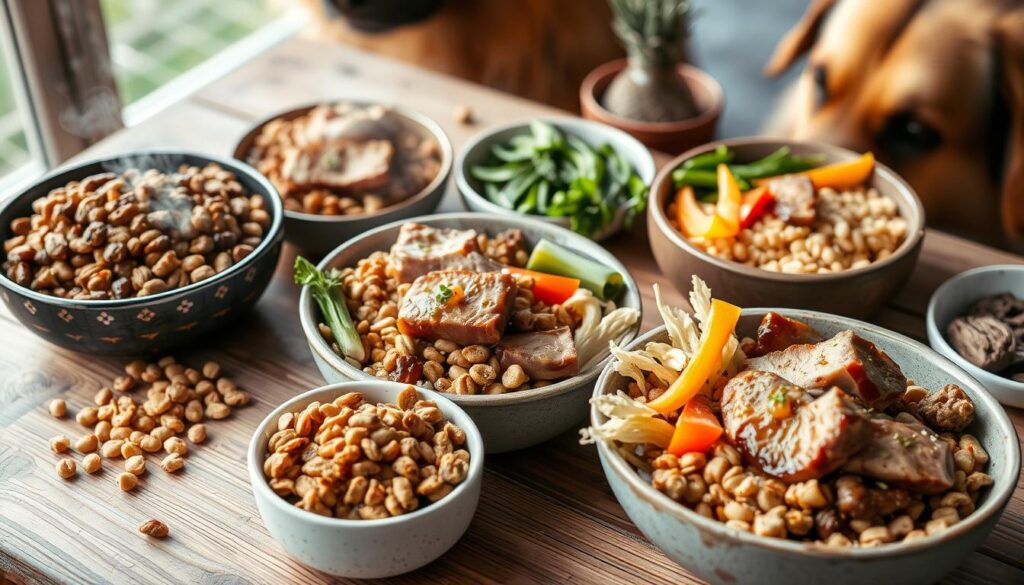
Diverse Recipes for Every Palate
Explore options like salmon with sweet potatoes or chicken-lentil stew, all developed with input from veterinary nutritionists. These meals meet AAFCO standards for complete nutrition, combining 40% protein, 30% veggies, and 30% whole grains. Popular choices include:
| Recipe | Key Ingredients | Special Features |
|---|---|---|
| Turkey & Quinoa Blend | Ground turkey, spinach, carrots | Grain-free option |
| Beef & Brown Rice Mix | Lean sirloin, brown rice, green beans | High iron content |
| Fish Medley | Salmon, peas, and pumpkin | Omega-3 rich |
Foolproof Preparation Methods
Every recipe includes precise measurements—like 1 cup cooked rice per 2 lbs of meat—and multiple cooking methods. Colorado pet owner Mia shares: “The Instant Pot chicken recipe takes 25 minutes start to finish. My shepherd licks his bowl clean every time!” Need substitutions? Swap lentils for rice in grain-sensitive pups or use venison for allergy-prone dogs.
Portion sizes adjust based on weight: ½ cup per 15 lbs of body weight twice daily. Always consult your vet before transitioning diets. With proper storage in airtight containers, these meals stay fresh for 5 days frozen or 3 days refrigerated.
Storage and Serving Tips for Optimal Freshness
Your effort in the kitchen deserves proper preservation. Well-stored meals maintain flavor and nutritional value while preventing bacterial growth. Let’s explore methods to extend your creations’ shelf life and serve perfect portions.
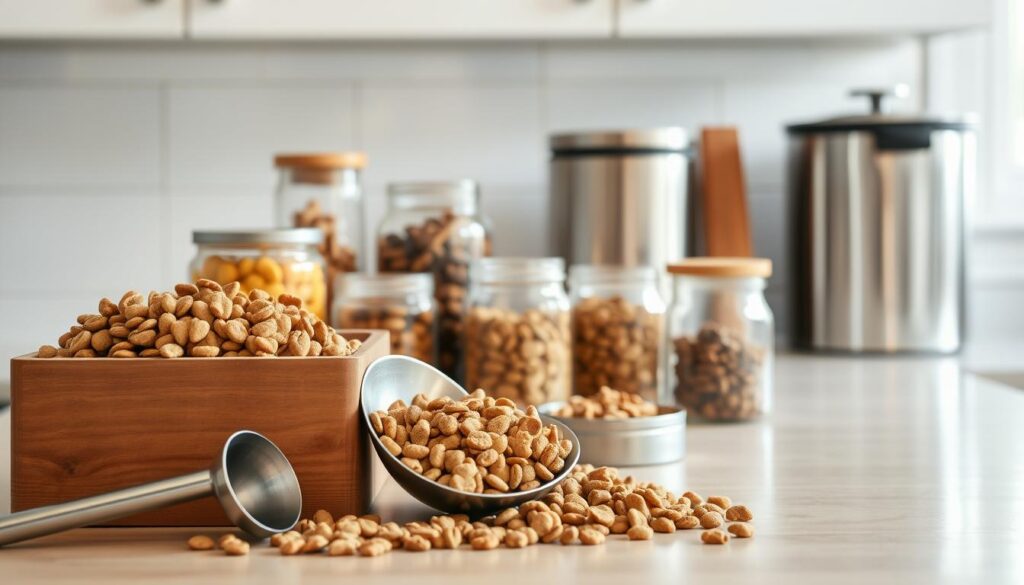
Smart Food Preservation Techniques
Cool cooked meals quickly using shallow containers. Wisconsin owner Tara shares: “I spread turkey-and-rice blends on baking sheets—they chill in half the time.” Follow these guidelines:
| Storage Method | Duration | Tips |
|---|---|---|
| Refrigeration | 3-5 days | Use glass containers with tight lids |
| Freezing | 2-3 months | Portion into silicone molds first |
| Room Temp | 2 hours max | Discard uneaten food promptly |
Serving Sizes That Match Energy Needs
Active breeds require precise fueling. A 2023 veterinary study recommends ½ cup per 15 pounds body weight twice daily. Here’s how that works:
- 40 lb dog → 1⅓ cups per meal
- 65 lb dog → 2¼ cups per meal
- 80 lb dog → 4 cups per meal
Thaw frozen portions in the fridge overnight. For quick reheating, mix with warm water instead of microwaving. Always use stainless steel bowls—they harbor fewer bacteria than plastic. Remember: proper storage completes your health-focused diet, keeping meals safe and delicious.
Foods to Avoid in Your German Shepherd’s Homemade Diet
Crafting meals for your loyal companion requires knowing what to exclude as much as what to include. While fresh ingredients fuel vitality, certain items can trigger serious health issues, from allergic reactions to organ damage.
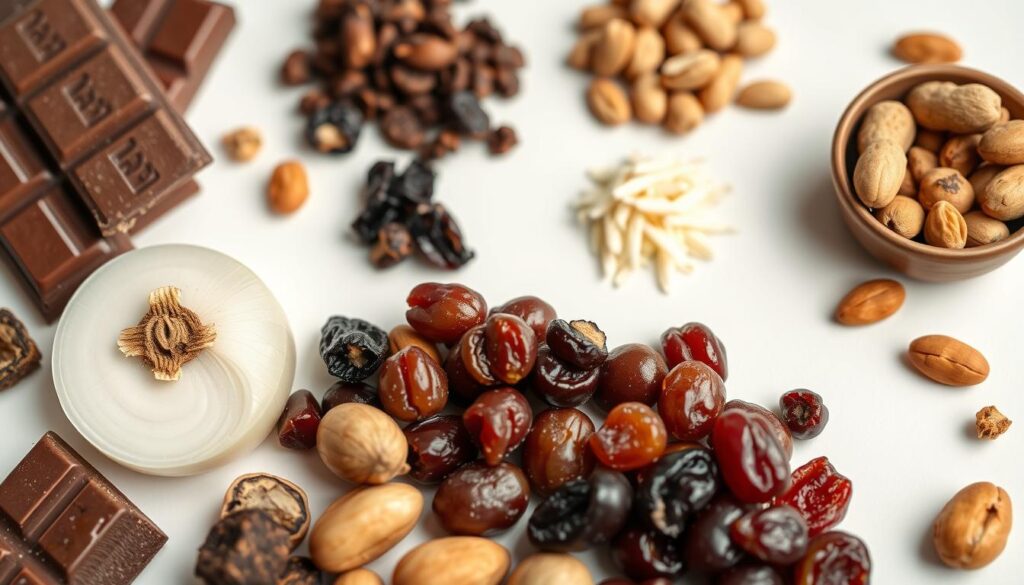
Common Allergens and Harmful Ingredients
These items should never appear in your dog’s bowl:
- Onions & garlic – Destroy red blood cells, leading to anemia. Minnesota owner Clara saw her shepherd’s energy rebound after removing garlic powder from meals.
- Chocolate & grapes – Toxic even in small amounts. A 2022 ASPCA report linked 12% of canine poisonings to accidental ingestion of these foods.
- Dairy products – Many shepherds lack the enzymes to digest lactose. Switching to goat’s milk resolved chronic diarrhea for Texas-based Loki, per his owner’s vet records.
Other frequent culprits include:
- Avocados (persin causes vomiting)
- Raw yeast dough (stomach expansion risk)
- Xylitol-sweetened treats (rapid blood sugar drops)
Veterinarian Dr. Sarah Klein warns: “Food sensitivities often manifest as itchy skin or ear infections. Track reactions in a diet journal and consult your vet immediately if symptoms appear.”
When introducing new ingredients, test one at a time over 3-5 days. This helps pinpoint triggers without guesswork. Remember: Your shepherd’s safety outweighs recipe convenience.
Customizing Recipes to Meet Your Dog’s Unique Nutritional Needs
Your shepherd’s bowl should evolve as they do. Active working dogs need different fuel than senior pets lounging at home. Start by tracking energy levels and weight changes weekly—these clues help you adjust recipes effectively.
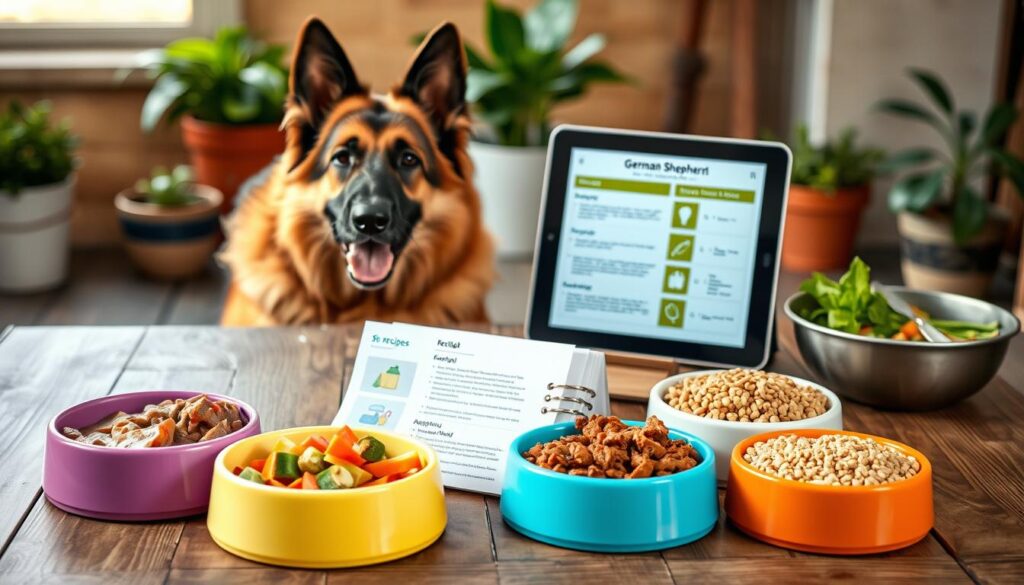
Fueling Different Lifestyles
High-energy dogs burn more calories. Increase lean proteins like ground turkey by 15% for working breeds, while reducing rice portions for less active companions. Minnesota owner Jake shares: “Cutting carbs by 20% helped my shepherd shed 8 pounds in three months.”
| Activity Level | Protein % | Grain % | Veggie % |
|---|---|---|---|
| Working Dog | 45 | 25 | 30 |
| Moderate Exercise | 40 | 30 | 30 |
| Senior/Low Activity | 35 | 35 | 30 |
Smart Swaps for Sensitive Systems
Common allergens hide in surprising places. Try these vet-approved substitutions:
- Beef → Turkey or rabbit meat
- Wheat → Oatmeal or quinoa
- Dairy → Calcium-fortified coconut milk
Veterinary nutritionist Dr. Lisa Park advises: “Always test new ingredients separately. Three days per trial helps identify triggers without confusion.” Keep a food journal, noting skin reactions or digestion changes.
Remember—small tweaks create big impacts. Swap carrots for green beans to reduce sugar intake, or add flaxseed for omega boosts. Partner with your vet to balance these changes while maintaining complete health support. Your dog’s vibrant energy and shiny coat will show when meals match their unique needs.
Conclusion
Seeing your German Shepherd thrive starts with what’s in their bowl. Fresh, balanced meals using quality ingredients can transform energy levels and coat health—just ask owners like Sarah and Mark. Their pups’ success stories prove tailored nutrition beats processed options every time.
Our vet-approved recipe collection makes it simple to fuel your companion’s adventures. From turkey-quinoa blends to omega-rich fish dishes, each meal addresses specific health needs while keeping tails wagging. Remember to adjust portions as your dog ages or activity levels change.
Start with one dish this week—maybe the salmon mix or beef-and-rice combo. Track improvements in digestion or stamina, and don’t hesitate to swap ingredients for allergy-friendly alternatives. Always partner with your vet when updating your pup’s diet.
Ready to dive deeper? Explore our complete guide to natural feeding for German Shepherds. Share your experiences below—we’d love to hear how homemade meals boost your furry friend’s vitality!
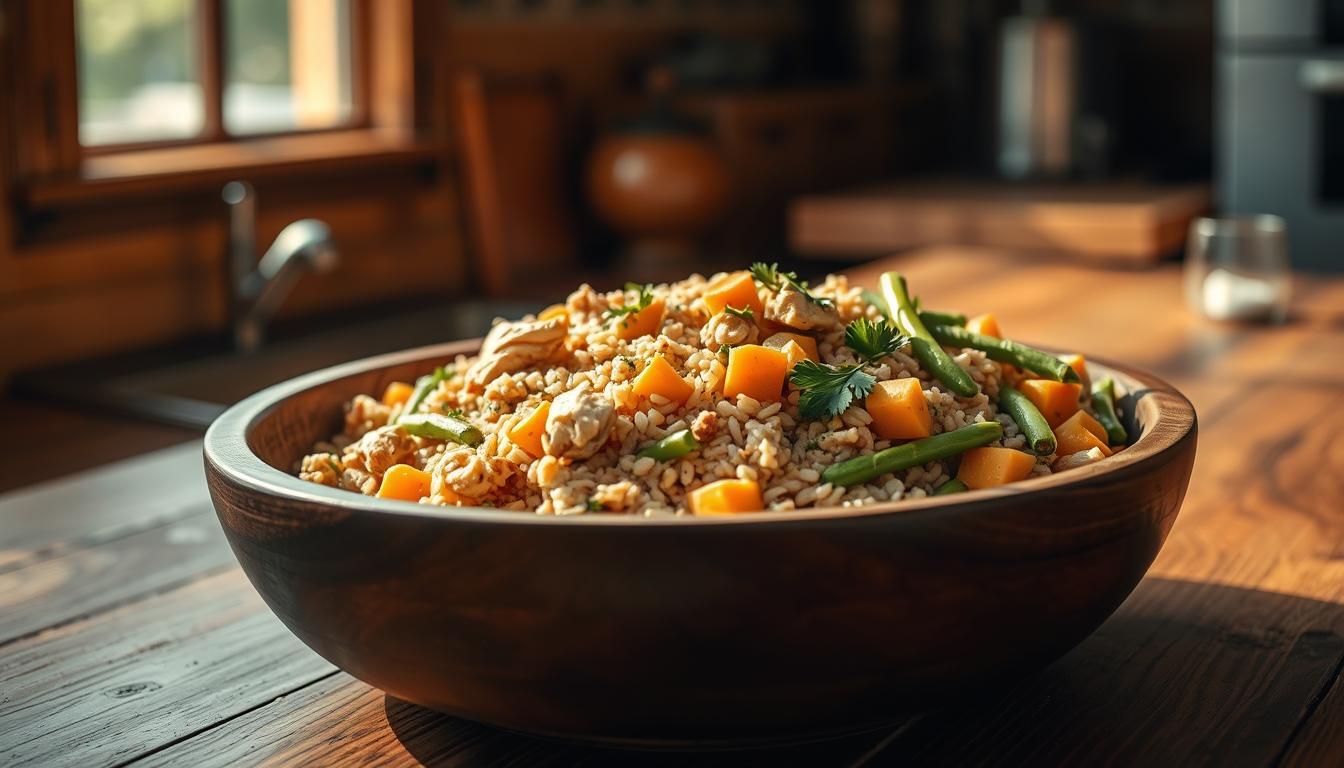
good content